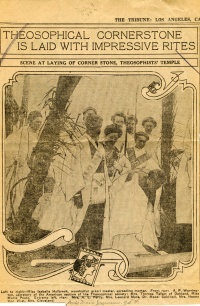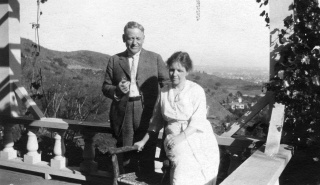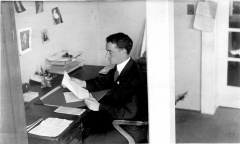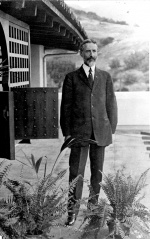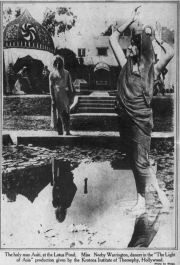Krotona in Hollywood
ARTICLE UNDER CONSTRUCTION
ARTICLE UNDER CONSTRUCTION
The Krotona colony of the American Theosophical Society was established in Hollywood, California in 1912 to serve as national headquarters and as an educational center. It was succeeded by the Krotona Institute of Theosophy and the Krotona School of Theosophy that are based in Ojai, California.
The idea behind Krotona
Selection of the site
The site for the new colony was in Beachwood Canyon, a tract of land within Hollywood Hills developed by Albert H. Beach. It was purchased by Henry Hotchener
Albert Powell Warrington, who became President of the American Theosophical Society in 1912, talked about the site selection process in a newspaper interview:
We chose this place because It is ideally situated. California furnishes an unsurpassed clime, and Los Angeles is the metropolis of a great melting pot from which is destined to emerge soon a new race; a people caused by the fusing of races now going on in this country. This will be the new American race, in whose hands will rest the solving of the problems now confronting the world.
That race will need wise guidance and great wisdom for the task: there must come a great world teacher and Theosophy will prepare the minds of men for his message. This teacher will not he a god. He will be a man; but with wisdom and insight to teach a new understanding of life...
Believing in the uplifting power of beauty, we shall make our buildings and grounds as beautiful as possible.[1]
In this message, Warrington referred to the Theosophical theories of Root-races and an anticipated new World Teacher.
Laying of the cornerstone
The Krotona cornerstone was laid on July 2, 1912 in a Co-Masonic rite conducted by Isabelle Holbrook, Marie Poutz, A. F. Knudsen, and American Theosophical Society President A. P. Warrington. Local newspapers covered the event.
The procession which formed at the crown of the hill and wound its way to the bottom presented a picturesque appearance. The white robes of the co-masons, men and women alike, wearing the same regalia, with their stoics of red embroidered in gold, or Alcyone blue embossed with silver, their emblems of office held a loft, heads bowed, suggested a medieval procession...
Reaching the cornerstone, a square was formed, symbolizing the obligations of all human beings one to another, the righteous squaring of all action. Grand Marshal August Knudsen conducted the ceremonies at the command of the worshipful master. Miss Holbrook, and the stone was laid according to ancient custom not where it serves as ornament but beneath the surface. All the Masonic symbols were used. The stone was squared, leveled and plumbed and the work of the craftsmen found correct. On it was poured water [corrected to say wheat], the symbol of physical action, wine, the symbol of life and joy, oil, the symbol of peace, and salt, the symbol of fruitfulness.
The act, when completed, was proclaimed in touching and solemn manner by Grand Orator Eleanor Broenneman, and the triangular trowel, placed on the square by the worshipful master. The members were conducted under cover by the tyler, Dr. Mabel Caldwell. A. P. Warrington, head of American section, who founded Krotona, said the building is not to be for the seclusion of a sect but for the use of the people and for this reason the base of the hill was chosen in order that it would be accessible to the public...
The building, which is to be the first of a series, and is to be known as the administration building, will be 52 x 85 feet in dimensions, of concrete, three stories in height and contain twenty rooms. Among these will be an assembly hall, dining room, cafeteria, co-operative stores, business offices, small lecture rooms and study rooms. It is designed to make the grounds into a public park. [2]
Mr. Warrington said:
We do not come to establish a sect with some limited form of truth, but to take the place of the inner temples of ancient times that held the esoteric side of great truths with key notes and interpretations of the hidden form of the wisdom that was given out in those days only to those who had proved worthy to be entrusted with its custody, but is now proclaimed to all. We seek no converts, for we have no creed to exalt, no church to build up; your creeds are our creeds, your churches our churches. The one religion that unites us all is the religion of Brotherhood, of universal tolerance.[3]
Charles T. Wood wrote an article on the beauty of the ceremony with a horoscope on the auspiciousness of the date.[4]
Construction and buildings
The construction in the 15-acre parcel was "an interesting compound with Moorish, Pueblo, Spanish Colonial and other architectural styles melded in a picturesque melange."[5]
On July 26, 1915 at the annual convention of the American Theosophical Society in San Francisco, attendees celebrated completion of the final payment of the $7500 of the $12,500 mortgage on the Krotona property. At that point, the value of the 15 acres and buildings was valued at about $110,000.[6]
The people at Krotona
UNDER CONSTRUCTION
UNDER CONSTRUCTION
Workers at Krotona were mostly unpaid volunteers. The President of the American Theosophical Society, A. P. Warrington first arrived in California in 1910.
L. W. Rogers and his young family had a house nearby at 2033 Argyle Avenue. He worked as the Propaganda Manager, and his wife May was editor of The Messenger, the Society's journal. Even after L.W. moved Society headquarters to Chicago in 1920, the family kept the Hollywood house as a base of operations, even into the 1940s. Their next-door neighbor was artist and Theosophist Beatrice Wood.
Wealthy and retired members bought land in the vicinity.
Other workers were young people. Fritz Kunz, for example, became one of the first residents in 1912, assisting A. P. Warrington for one year with office work and editing periodicals. The president appointed him as one of six General Secretary's Representatives, a group of "helpers" working with the lodges in various regions. Kunz was assigned to work with lodges in California, Utah, Nevada, Hawai'i, and Arizona.[7] Another assignment was as registrar for the first summer school at Krotona, which involved arranging room and board for over one hundred people. Although Kunz enjoyed the work and the adventure of establishing a new institution, he had to leave after a year because he could not afford to work unpaid.
Educational activities
From the beginning, the Krotona campus was intended to support educational functions. Carlos G. Hardy was to be dean of a new university. He said "We will follow, in this Institution, the lines laid down by our president [of the international Theosophical Society], Annie Besant, which are strongly educational."[8] In describing the proposed educational program, A. P. Warrington said,
Theosophy is the lost key to life; with the understanding it gives, we shall teach in the school we are opening here the same branches that are taught in any modern university.
At first we shall endeavor to correlate Christianity with Theosophy, science with Theosophy. There will also he classes in nutrition and vegetarianism. We are not offering a religion, but a philosophy оГ life.
We hope this work will be the nucleus of the greatest of modern universities. We shall of course work under the direction of our President, Mrs. Anne Besant, who lives in India. We believe we are pioneers for the great educational movement of the future.[9]
Other activities at Krotona
A theatrical version Edwin Arnold's The Light of Asia was presented in 1918 in the upper gardens at Krotona, running for 35 performances in the Krotona Stadium that could seat 800 people, and also in Beachwood Canyon.[10] Neely Warrington, the daughter of American Theosophical Society president A. P. Warrington, was one of the performers. Walter Hampden starred as Siddhartha, with music by Camille Zekwer and Charles Wakefield Cadman, and the famous choreographer Ruth St. Denis with dancers from her Denishawn company. Christine Wetherill Stevenson, a Theosophist from Philadelphia, commissioned the dramatization and sponsored the production.
Move of Krotona to Ojai
In 1924, with Dr. Besant's approval, Mr. Warrington ordered the Hollywood Krotona estates to be sold and the center removed to Ojai Valley where it is now located on a lovely site of a mid-valley hill, or ridge, chosen by Mr. Warrington because of its very great beauty.[11]
From this point, the story continues under Krotona Institute of Theosophy.
Additional resources
Books
- Hine, Robert V. California's Utopian Colonies. Yale Western Americana series. New York: Norton, 1973.
- Ross, Joseph E. Volume I: Krotona of Old Hollywood 1866-1913. Montecito, Calif.: El Montecito Oaks Press, 1989.
- Ross, Joseph E. Volume II: Krotona of Old Hollywood 1914-1920. Montecito, Calif.: El Montecito Oaks Press, 2004.
- Ross, Joseph E. Volume III: Krotona the New Krotona from Hollywood to Ojai 1921-1922. Montecito, Calif.: El Montecito Oaks Press, 2009.
- Ross, Joseph E. Volume IV: Krotona in the Ojai Valley 1923-1926. Montecito, Calif.: El Montecito Oaks Press, 2009.
Articles
- Meares, Hadley. "The Creation of Beachwood Canyon's Theosophist 'Dreamland'"
- Willis, Alfred. "A Survey of Surviving Buildings of the Krotona Colony in Hollywood" University of California, Los Angeles. Archived from the original PDF on 2009-05-29.
Video
- Under the Hollywood Sign by Hope Anderson. April 22, 2014. Documentary can be downloaded for a fee. "A cultural history and present-day examination of a unique urban village, 'Under the Hollywood Sign' combines new HD footage with interviews, archival footage and stills to tell the story of Beachwood Canyon, home of the Hollywood Sign."
Notes
- ↑ Anonymous, "'Neither Occult nor Mystery,' Says Head of New Cult School" unnamed Los Angeles newspaper. May 22, 1912. Theosophical Society in America Archives.
- ↑ Clipping from unidentified newspaper. Theosophical Society in America Archives.
- ↑ Clipping from unidentified newspaper. Theosophical Society in America Archives.
- ↑ Charles T. Wood "The Horoscope" The Theosophic Messenger 13 no.11 (August, 1912), 631-633.
- ↑ Paul R. Spitzzeri, "Take It On Faith: A Press Photo of the Krotona Institute of Theosophy, Beachwood Canyon, Hollywood, 1913" in The Homestead Blog. Posted by the Homestead Museum on June 6, 2022.
- ↑ Anonymous, "$7500 Mortgage on Krotona Institute Burned at Bay City" Express (July 27, 1915). See [https://homesteadmuseum.blog/2022/06/06/take-it-on-faith-a-press-photo-of-the-krotona-institute-of-theosophy-beachwood-canyon-hollywood-1913/ Spitzzeri article in Homestead Museum blog.
- ↑ "General Secretary's Representatives" The Theosophic Messenger 13.9 (June 1912): 514.
- ↑ Clipping from unidentified newspaper. Theosophical Society in America Archives.
- ↑ Anonymous, "'Neither Occult nor Mystery,' Says Head of New Cult School" unnamed Los Angeles newspaper. May 22, 1912. Theosophical Society in America Archives.
- ↑ Catherine Parsons Smith, Making Music in Los Angeles: Transforming the Popular, (Berkeley: University of California Press, 2007), 135.
- ↑ "A. P. Warrington." The American Theosophist 27.7 (July, 1939), 149.
